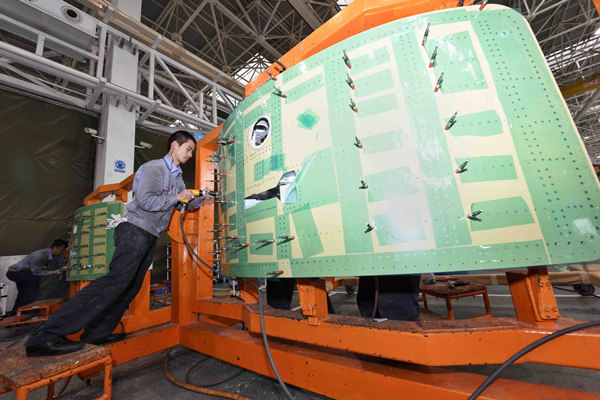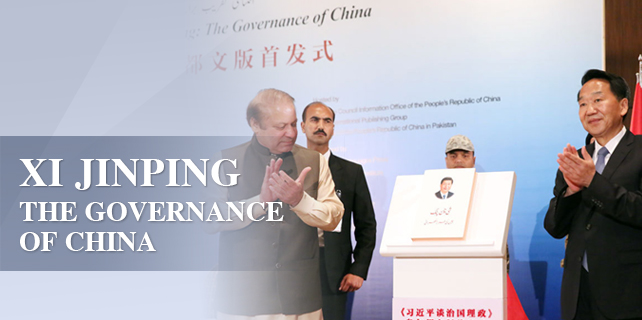Innovation nation
 |
|
Workers assemble parts for an A320 aircraft at an AVIC Chengdu Aircraft Industrial plant. The company has innovated and integrated its technologies, which were previously developed for national defense purposes. XINHUA |
Multiple tech centers
Many disparate areas in China are emerging as technology hubs, such as Shanghai, Shenzhen, Chengdu, Guangdong province, Hong Kong and Tianjin.
A recent survey by accounting firm KPMG rated Shanghai as the most likely city to rival Silicon Valley in the future
The survey, titled The Changing Landscape of Disruptive Technologies, polled 832 technology leaders; 43 percent believe the tech innovation center of the world is likely to move from Silicon Valley to another country in the next four years, with China picked as the most likely alternative.
Sixty-five percent of respondents said China could replace the California giant in four years.
Shanghai was tabbed by 26 percent of respondents as the next Silicon Valley, followed by New York, Tokyo, Beijing and London.
"Shanghai is bound to remain among the world's leading innovation hubs given its growing base of digital media and entertainment companies and a more pleasurable lifestyle and favorable climate that can draw top expertise," said Egidio Zarrella, partner of clients and innovation at KPMG China.
"The success of the Silicon Valley ecosystem has yielded a real innovation entrepreneurship throughout the world, and China has taken advantage of it, leveraging the massive consumer base in China," said Tim Zanni, KPMG's global and US technology leader.
"Silicon Valley has a developed mentor community, but the mentor community is extremely poor in China," he said. "The big banks in China haven't yet put their arms around startups to help them, and there hasn't been any big brother or big sister to help startups. This is one big thing we are missing from Silicon Valley," Zarrella added.
"It is just part of the evolution. If you have smart young people, great universities and sufficient government support and equity capital coming in, there will be a successful company, and the company will breed more successful companies," Zarrella said.
In the KPMG report, China was second only to the United States in being the country most likely to produce disruptive technologies that have global impact.
Chengdu, capital of Southwest China's Sichuan province, is turning from a traditional military-industrial base into an innovation star, due to China's civil-military integration strategy.
President Xi Jinping urged the military at the 12th National People's Congress in Beijing on March 12 to further boost integration with civilian sectors while highlighting scientific and technological innovation as the key to military upgrades.
Xi told officers to look for, support and make use of advanced technologies that can help modernize the military and assist the transfer of defense technologies to the business sector.
Institutional barriers and special interest groups must be removed to pave the way for civilian-defense integration, he said.
Beijing Venustech Inc, a provider of network security, has opened a branch in Chengdu Science City, a hub of technology, industry and business in the Tianfu New Area.
There also was a call at the two sessions for the Pearl River Delta area to be transformed into a tech hot spot.
Ma Huateng, chairman of Tencent and a deputy to the NPC, said the Guangdong-Hong Kong and Macao Bay Area could be a global technology hub.
"Hong Kong will take the lead among these cities in international transportation, as well as accounting and financial, legal and other commercial services. Dongguan (in Guangdong) specializes in manufacturing. And Shenzhen hosts China's high-tech giants, such as Tencent and Huawei as well as drone maker DJI," he said.
Such a new "Silicon Valley" could be girded by the completion next year of the Hong Kong-Zhuhai-Macao Bridge.
The span will link Zhuhai in Guangdong with Hong Kong and Macao and be the world's longest sea-crossing bridge. The area is one of China's most affluent, with a GDP of 2 trillion yuan in 2016.
Shenzhen has become a hotbed of startup tech firms. Some 16 percent of the city's population was engaged in early-stage entrepreneurial activities in 2016.
On March 27, computer maker Lenovo Group Ltd signed a strategic partnership agreement with Tianjin in North China to expand its smart internet business.
"A new era for smart internet has come. In the future, China's economy will be increasingly driven by technology," said He Zhiqiang, president of Lenovo Capital and Incubator Group.
Several subsidiaries and enterprises invested in by Lenovo will cooperate with the Binhai New Area of Tianjin on augmented reality, cloud computing and medical information.
Internet company Baidu set up a national deep learning technology lab in Beijing in March.
"The internet is just an appetizer. The main course will be AI. In the future, machines will develop to a point where they can understand humans and their intentions," said Li Yanhong, chairman of Baidu, at the China IT Summit in Shenzhen earlier this month.
Baidu has invested in machine-aided study, image recognition, voice recognition and driverless vehicles.
Xiaomi set up an "Explorer's Lab" last year to research artificial intelligence and will release an "exciting AI product" in the coming six months, said Lei Jun, founder and CEO.
Diverse industries
"If we define 2016 as the first year of China's artificial intelligence, this year will be the beginning of applications of artificial intelligence in the country," said Liu Qingfeng, chairman of tech firm iFlytek Co Ltd.
"We will accelerate R&D on and commercialization of new materials, artificial intelligence, integrated circuits, biopharmacy, 5G mobile communications and other technologies and develop industrial clusters in these fields," said the Government Work report released in March.
Wang Qing, professor of marketing and innovation at Warwick Business School, said China is catching up with the West after lagging during the reform and opening-up in the 1970s.
"I think China in some areas already is very close to what is cutting edge and, maybe in a couple of areas, they might even be more advanced," she said.
She believes one such area is high-speed rail. China opened its first line in 2007 and now operates 19,000 kilometers of track, more than the rest of the world's high-speed rail networks combined.
"They actually started in high-speed rail by borrowing Japanese technology, but because of a lot of unique problems, they had to do lots of innovations on top because of what they learned," she said.
"Because of the scale of the country's high-speed rail development, they have also accumulated experience that some other countries would not have."
"Innovation is to some extent a numbers game. If you just have one idea per 1,000 people, then a country that has a 1.4 billion population is going to have an advantage over anyone else," said Max von Zedtwitz, managing director of GLORAD, an R&D think tank in Shanghai and San Francisco.
But China is not going it alone on innovation. In fact, it's quite the contrary.
"It has done so not in isolation," said Fraser, the Duke Jinshan professor. "What really is happening is that the Chinese now are seeing themselves benefiting from having a rather expansive set of international science and technology relations. And those relationships are now yielding big results.
"It's very much a globally integrated innovation," he said. "China is benefitting substantially by its engagement with the West and other parts of the world, the mobility of Chinese scientists, the fact that international conferences, major conferences and workshops are held in China.
"Innovation no longer occurs in a kind of Lone Ranger motif. … Everyone is now part of some transnational collaborative knowledge network. And increasingly, Chinese scientists are a regular part of those networks," he said.
"And that's what I think is helping to spur Chinese innovation. It's the changes within the system, combined with the increasing integration into the international science and technology system, that now have enabled China to move forward in a much faster, much more concerted way than it has in the past."
Contact the writer at williamhennelly@chinadailyusa.com
















